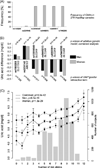Sex and age interaction with genetic association of atherogenic uric acid concentrations
- PMID: 20053405
- PMCID: PMC3793203
- DOI: 10.1016/j.atherosclerosis.2009.12.013
Sex and age interaction with genetic association of atherogenic uric acid concentrations
Abstract
Background: High serum uric acid levels are associated with gout, atherosclerosis and cardiovascular disease. Three genes (SLC2A9, ABCG2, and SLC17A3) were reported to be involved in the regulation of uric acid levels.
Design and methods: SNPs rs2231142 (ABCG2) and rs1165205 (SLC17A3) were genotyped in three cohorts (n=4492) and combined with previously genotyped SNPs within SLC2A9 (rs6855911, rs7442295, rs6449213, rs12510549).
Results: Each copy of the minor allele decreased uric acid levels by 0.30-0.38 mg/dL for SLC2A9 (p values: 10(-20)-10(-36)) and increased levels by 0.34 mg/dL for ABCG2 (p=1.1x10(-16)). SLC17A3 influenced uric acid levels only modestly. Together the SNPs showed graded associations with uric acid levels of 0.111 mg/dL per risk allele (p=3.8x10(-42)). In addition, we observed a sex-specific interaction of age with the association of SLC2A9 SNPs with uric acid levels, where increasing age strengthened the association of SNPs in women and decreased the association in men.
Conclusions: Genetic variants within SLC2A9,ABCG2 and SLC17A3 show highly significant associations with uric acid levels, and for SNPs within SLC2A9 this association is strongly modified by age and sex.
Copyright (c) 2009 Elsevier Ireland Ltd. All rights reserved.
Figures


Similar articles
-
The association between genetic polymorphisms in ABCG2 and SLC2A9 and urate: an updated systematic review and meta-analysis.BMC Med Genet. 2020 Oct 21;21(1):210. doi: 10.1186/s12881-020-01147-2. BMC Med Genet. 2020. PMID: 33087043 Free PMC article.
-
Genetic analysis of ABCG2 and SLC2A9 gene polymorphisms in gouty arthritis in a Korean population.Korean J Intern Med. 2015 Nov;30(6):913-20. doi: 10.3904/kjim.2015.30.6.913. Epub 2015 Oct 30. Korean J Intern Med. 2015. PMID: 26552468 Free PMC article.
-
Common polymorphisms influencing serum uric acid levels contribute to susceptibility to gout, but not to coronary artery disease.PLoS One. 2009 Nov 5;4(11):e7729. doi: 10.1371/journal.pone.0007729. PLoS One. 2009. PMID: 19890391 Free PMC article.
-
ABCG2 rs2231142 variant in hyperuricemia is modified by SLC2A9 and SLC22A12 polymorphisms and cardiovascular risk factors in an elderly community-dwelling population.BMC Med Genet. 2020 Mar 17;21(1):54. doi: 10.1186/s12881-020-0987-4. BMC Med Genet. 2020. PMID: 32183743 Free PMC article.
-
Genetics of gout.Curr Opin Rheumatol. 2010 Mar;22(2):144-51. doi: 10.1097/BOR.0b013e32833645e8. Curr Opin Rheumatol. 2010. PMID: 20110790 Review.
Cited by
-
Immunohistochemical analysis of transporters related to clearance of amyloid-β peptides through blood-cerebrospinal fluid barrier in human brain.Histochem Cell Biol. 2015 Dec;144(6):597-611. doi: 10.1007/s00418-015-1366-7. Epub 2015 Oct 8. Histochem Cell Biol. 2015. PMID: 26449856
-
The Relationship between Serum Uric Acid Levels and Early Mortality in Chronic Obstructive Pulmonary Disease Cases during Exacerbation.Sarcoidosis Vasc Diffuse Lung Dis. 2022;39(2):e2022014. doi: 10.36141/svdld.v39i2.12127. Epub 2022 Jun 29. Sarcoidosis Vasc Diffuse Lung Dis. 2022. PMID: 36118541 Free PMC article.
-
The association between genetic polymorphisms in ABCG2 and SLC2A9 and urate: an updated systematic review and meta-analysis.BMC Med Genet. 2020 Oct 21;21(1):210. doi: 10.1186/s12881-020-01147-2. BMC Med Genet. 2020. PMID: 33087043 Free PMC article.
-
ABCG transporters and disease.FEBS J. 2011 Sep;278(18):3215-25. doi: 10.1111/j.1742-4658.2011.08171.x. Epub 2011 Jun 13. FEBS J. 2011. PMID: 21554546 Free PMC article. Review.
-
Serum uric acid and adiposity: deciphering causality using a bidirectional Mendelian randomization approach.PLoS One. 2012;7(6):e39321. doi: 10.1371/journal.pone.0039321. Epub 2012 Jun 19. PLoS One. 2012. PMID: 22723994 Free PMC article.
References
-
- Richette P, Bardin T. Gout Lancet. in press.
-
- Chen JH, Chuang SY, Chen HJ, Yeh WT, Pan WH. Serum uric acid level as an independent risk factor for all-cause, cardiovascular, and ischemic stroke mortality: a Chinese cohort study. Arthritis Rheum. 2009;61:225–232. - PubMed
-
- Fang J, Alderman MH. Serumuric acid and cardiovascular mortality theNHANES I epidemiologic follow-up study, 1971–1992. National health and nutrition examination survey. JAMA. 2000;283:2404–2410. - PubMed
-
- Hozawa A, Folsom AR, Ibrahim H, et al. Serum uric acid and risk of ischemic stroke: the ARIC Study. Atherosclerosis. 2006;187:401–407. - PubMed
-
- Döring A, Gieger C, Mehta D, et al. SLC2A9 influences uric acid concentrations with pronounced sex-specific effects. Nat Genet. 2008;40:430–436. - PubMed
Publication types
MeSH terms
Substances
Grants and funding
LinkOut - more resources
Full Text Sources
Medical
Molecular Biology Databases

